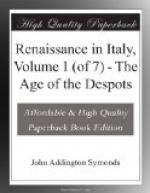[1] See Prato and Burigozzo, Arch. Stor. vol. iii. pp. 357, 431. It is here worth noticing that Siena, the city of civil discord, was also the city of frenetic piety. The names of S. Caterina, S. Bernardino, and Bernardo Tolomei occur to the mind.
[2] Storia Fiorintina, vol. i. p. 87.
[3] Arch. Stor. vol. iii. p. 443.
[4] Burigozzo, pp. 485-89.
Enough has now been quoted from various original sources to illustrate the feverish recurrences of superstitious panics in Italy during the Middle Ages and the Renaissance. It will be observed, from what has been said about John of Vicenza, Jacopo del Bussolaro, S. Bernardino, Roberto da Lecce, Giovanni della Marca, and Fra Capistrano, that Savonarola was by no means an extraordinary phenomenon in Italian history. Combining the methods and the aims of all these men, and remaining within the sphere of their conceptions, he impressed a role, which had been often played in the chief Italian towns, with the stamp of his peculiar genius. It was a source of weakness to him in his combat with Alexander VI., that he could not rise above the monastic ideal of the prophet which prevailed in Italy, or grasp one of those regenerative conceptions which formed the motive force of the Reformation. The inherent defects of all Italian revivals, spasmodic in their paroxysms, vehement while they lasted, but transient in their effects, are exhibited upon a tragic scale by Savonarola. What strikes us, after studying the records of these movements in Italy, is chiefly their want of true mental energy. The momentary effect produced in great cities like Florence, Milan, Verona, Pavia, Bologna, and Perugia is quite out of proportion to the slight intellectual power exerted




